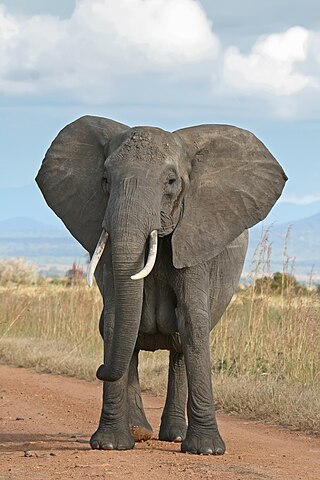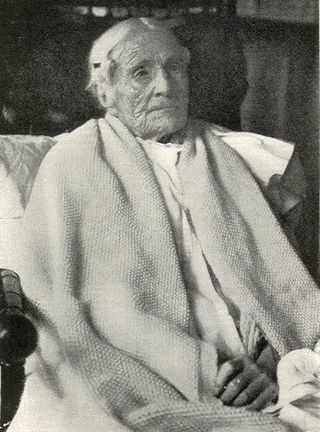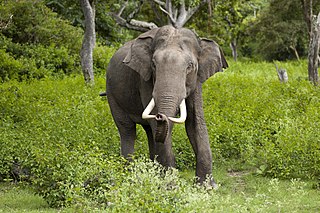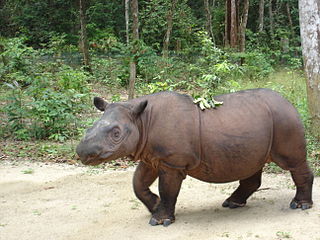Related Research Articles

Elephants are the largest living land animals. Three living species are currently recognised: the African bush elephant, the African forest elephant, and the Asian elephant. They are the only surviving members of the family Elephantidae and the order Proboscidea; extinct relatives include mammoths and mastodons. Distinctive features of elephants include a long proboscis called a trunk, tusks, large ear flaps, pillar-like legs, and tough but sensitive grey skin. The trunk is prehensile, bringing food and water to the mouth and grasping objects. Tusks, which are derived from the incisor teeth, serve both as weapons and as tools for moving objects and digging. The large ear flaps assist in maintaining a constant body temperature as well as in communication. African elephants have larger ears and concave backs, whereas Asian elephants have smaller ears and convex or level backs.

Senescence or biological aging is the gradual deterioration of functional characteristics in living organisms. The word senescence can refer to either cellular senescence or to senescence of the whole organism. Organismal senescence involves an increase in death rates and/or a decrease in fecundity with increasing age, at least in the later part of an organism's life cycle. but it can be delayed. The 1934 discovery that calorie restriction can extend lifespans by 50% in rats, the existence of species having negligible senescence, and the existence of potentially immortal organisms such as members of the genus Hydra have motivated research into delaying senescence and thus age-related diseases. Rare human mutations can cause accelerated aging diseases.

The Asian elephant, also known as the Asiatic elephant, is the only living species of the genus Elephas and is distributed throughout the Indian subcontinent and Southeast Asia, from India in the west, Nepal in the north, Sumatra in the south, and to Borneo in the east. Three subspecies are recognised—E. m. maximus from Sri Lanka, E. m. indicus from mainland Asia and E. m. sumatranus from the island of Sumatra. Formerly, there was also the Syrian elephant or Western Asiatic elephant which was the westernmost population of the Asian elephant. This subspecies became extinct in ancient times. Skeletal remains of E. m. asurus have been recorded from the Middle East: Iran, Iraq, Syria, and Turkey from periods dating between at least 1800 BC and likely 700 BC. It is one of only three living species of elephants or elephantids anywhere in the world, the others being the African bush elephant and African forest elephant. It is the second largest species of elephant after the African bush elephant.

The Sumatran rhinoceros, also known as the Sumatran rhino, hairy rhinoceros or Asian two-horned rhinoceros, is a rare member of the family Rhinocerotidae and one of five extant species of rhinoceros; it is the only extant species of the genus Dicerorhinus. It is the smallest rhinoceros, although it is still a large mammal; it stands 112–145 cm (44–57 in) high at the shoulder, with a head-and-body length of 2.36–3.18 m and a tail of 35–70 cm (14–28 in). The weight is reported to range from 500–1,000 kg (1,100–2,200 lb), averaging 700–800 kg (1,540–1,760 lb). Like both African species, it has two horns; the larger is the nasal horn, typically 15–25 cm (5.9–9.8 in), while the other horn is typically a stub. A coat of reddish-brown hair covers most of the Sumatran rhino's body.

Reproductive success is an individual's production of offspring per breeding event or lifetime. This is not limited by the number of offspring produced by one individual, but also the reproductive success of these offspring themselves.

The grandmother hypothesis is a hypothesis to explain the existence of menopause in human life history by identifying the adaptive value of extended kin networking. It builds on the previously postulated "mother hypothesis" which states that as mothers age, the costs of reproducing become greater, and energy devoted to those activities would be better spent helping her offspring in their reproductive efforts. It suggests that by redirecting their energy onto those of their offspring, grandmothers can better ensure the survival of their genes through younger generations. By providing sustenance and support to their kin, grandmothers not only ensure that their genetic interests are met, but they also enhance their social networks which could translate into better immediate resource acquisition. This effect could extend past kin into larger community networks and benefit wider group fitness.

Captive breeding, also known as captive propagation, is the process of keeping plants or animals in controlled environments, such as wildlife reserves, zoos, botanic gardens, and other conservation facilities. It is sometimes employed to help species that are being threatened by the effects of human activities such as climate change, habitat loss, fragmentation, overhunting or fishing, pollution, predation, disease, and parasitism.

The Sri Lankan elephant is native to Sri Lanka and one of three recognised subspecies of the Asian elephant. It is the type subspecies of the Asian elephant and was first described by Carl Linnaeus under the binomial Elephas maximus in 1758. The Sri Lankan elephant population is now largely restricted to the dry zone in the north, east and southeast of Sri Lanka. Elephants are present in Udawalawe National Park, Yala National Park, Lunugamvehera National Park, Wilpattu National Park and Minneriya National Park but also live outside protected areas. It is estimated that Sri Lanka has the highest density of elephants in Asia. Human-elephant conflict is increasing due to conversion of elephant habitat to settlements and permanent cultivation.
Life history theory is an analytical framework designed to study the diversity of life history strategies used by different organisms throughout the world, as well as the causes and results of the variation in their life cycles. It is a theory of biological evolution that seeks to explain aspects of organisms' anatomy and behavior by reference to the way that their life histories—including their reproductive development and behaviors, post-reproductive behaviors, and lifespan —have been shaped by natural selection. A life history strategy is the "age- and stage-specific patterns" and timing of events that make up an organism's life, such as birth, weaning, maturation, death, etc. These events, notably juvenile development, age of sexual maturity, first reproduction, number of offspring and level of parental investment, senescence and death, depend on the physical and ecological environment of the organism.

The Indian elephant is one of three extant recognised subspecies of the Asian elephant and native to mainland Asia.
Enquiry into the evolution of ageing, or aging, aims to explain why a detrimental process such as ageing would evolve, and why there is so much variability in the lifespans of organisms. The classical theories of evolution suggest that environmental factors, such as predation, accidents, disease, and/or starvation, ensure that most organisms living in natural settings will not live until old age, and so there will be very little pressure to conserve genetic changes that increase longevity. Natural selection will instead strongly favor genes which ensure early maturation and rapid reproduction, and the selection for genetic traits which promote molecular and cellular self-maintenance will decline with age for most organisms.

Project Elephant was launched in 1992 by the Government of India Ministry of Environment and Forests to provide financial and technical support to wildlife management efforts by states for their free-ranging populations of wild Asian Elephants. The project aims to ensure the long-term survival of the population of elephants in their natural habitats by protecting them, their habitats and migration corridors. Other goals of Project Elephant are supporting the research of the ecology and management of elephants, creating awareness of conservation among local people, and providing improved veterinary care for captive elephants.
Ageing is the process of becoming older. The term refers mainly to humans, many other animals, and fungi, whereas for example, bacteria, perennial plants and some simple animals are potentially biologically immortal. In a broader sense, ageing can refer to single cells within an organism which have ceased dividing, or to the population of a species.

The African bush elephant, also known as the African savanna elephant, is one of two extant African elephant species and one of three extant elephant species. It is the largest living terrestrial animal, with bulls reaching a shoulder height of up to 3.96 m and a body mass of up to 10.4 t.
Elephant endotheliotropic herpesviruses (EEHV) or Elephantid betaherpesvirus 1 (ElHV-1) is a type of herpesvirus, which can cause a highly fatal hemorrhagic disease when transmitted to young Asian elephants. In African elephants, related forms of these viruses, which have been identified in wild populations, are generally benign, occasionally surfacing to cause small growths or lesions. However, some types of EEHV can cause a highly fatal disease in Asian elephants, which kills up to 80% of severely affected individuals. The disease can be treated with the rapid application of antiviral drugs, but this has only been effective in around a third of cases.
The patriarch hypothesis is a hypothesis that explains the occurrence of menopause in human females and how a long post-fertile period could confer an evolutionary advantage. It is an alternative theory to the grandmother hypothesis which tends to ignore male benefits of continued spermatogenesis and their roles in assistance.

Elephants can be found in various captive facilities such as a zoo, sanctuary, circus, or camp, usually under veterinary supervision. They can be used for educational, entertainment, or work purposes.
The disposable soma theory of aging states that organisms age due to an evolutionary trade-off between growth, reproduction, and DNA repair maintenance. Formulated by Thomas Kirkwood, the disposable soma theory explains that an organism only has a limited amount of resources that it can allocate to its various cellular processes. Therefore, a greater investment in growth and reproduction would result in reduced investment in DNA repair maintenance, leading to increased cellular damage, shortened telomeres, accumulation of mutations, compromised stem cells, and ultimately, senescence. Although many models, both animal and human, have appeared to support this theory, parts of it are still controversial. Specifically, while the evolutionary trade-off between growth and aging has been well established, the relationship between reproduction and aging is still without scientific consensus, and the cellular mechanisms largely undiscovered.
Extrinsic mortality is the sum of the effects of external factors, such as predation, starvation and other environmental factors not under control of the individual that cause death. This is opposed to intrinsic mortality, which is the sum of the effects of internal factors contributing to normal, chronologic aging, such as, for example, mutations due to DNA replication errors, and which determined species maximum lifespan. Extrinsic mortality plays a significant role in evolutionary theories of aging, as well as the discussion of health barriers across socioeconomic borders.
Few animals have a menopause: humans are joined by just four other species in which females live substantially longer than their ability to reproduce. The others are all cetaceans: beluga whales, narwhals, orcas and short-finned pilot whales. There are various theories on the origin and process of the evolution of menopause. These attempt to suggest evolutionary benefits to the human species stemming from the cessation of women's reproductive capability before the end of their natural lifespan. Explanations can be categorized as adaptive and non-adaptive:
References
- 1 2 3 4 "Virpi Lummaa". European Research Council . n.d. Retrieved 2020-06-11.
- 1 2 3 4 "The Team". Myanmar Timber Elephant Project. University of Turku. n.d. Retrieved 2020-06-11.
- 1 2 "Group Members". Human Life History Group. University of Turku. n.d. Retrieved 2020-06-11.
- ↑ Yeager, Ashley (2019-02-07). "'Grandmother Hypothesis' Gets Some Support". The Scientist . Retrieved 2020-06-11.
- ↑ Cell Press (2019-02-07). "Studies Lend Support to 'Grandmother Hypothesis,' but There Are Limits". ScienceDaily . Retrieved 2020-06-11.
- ↑ Harvey, Olivia (2019-02-09). "Kids Benefit from Grandmother Involvement, Until a Certain Point". Earth.com. Retrieved 2020-06-11.
- ↑ Devlin, Hannah (2019-07-26). "What Is the Menopause and When Does It Strike?". The Guardian . Retrieved 2020-06-11.
- ↑ Whyte, Chelsea (2019-03-18). "Women with a Twin Brother Are More Likely to Drop Out of School". New Scientist . Retrieved 2020-06-11.
- ↑ Pennisi, Elizabeth (2014-12-11). "Why Women's Bodies Abort Males During Tough Times". Science . Retrieved 2020-06-11.
- ↑ Choi, Charles Q. (2012-04-30). "Humans Really Are Still Evolving, Study Finds". Live Science . Retrieved 2020-06-11.
- ↑ Hullinger, Jessica (2015-10-26). "5 Signs Humans Are Still Evolving". Mental Floss . Retrieved 2020-06-11.
- 1 2 3 4 5 Gillman, Steve (2019-02-14). "Elephant Genes Suppress Tumours. Could Studying This Help Us Prevent Cancer?". Horizon . Retrieved 2020-06-11.
- ↑ "Sisters Improve Chances of Reproduction in Asian Elephants" (Press release). University of Turku. 2017-07-24. Retrieved 2020-06-11.
- 1 2 University of Sheffield (2019-03-26). "Future of Elephants Living in Captivity Hangs in the Balance". ScienceDaily. Retrieved 2020-06-11.
- ↑ Sharma, Ruchira (2019-03-28). "Young Captive Asian Elephants Are Dying Due to the Stress of Being Taken from Their Mothers to Work in Tourism". i . Retrieved 2020-06-11.